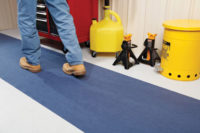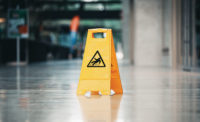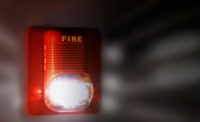
When smoke fills a room or uncontrolled flames become visible in a building, it’s almost inevitable that someone will panic. Unfortunately, it is impossible to completely engineer this dynamic out of emergency plans. However, making it as easy as possible for people to get out of a building, and performing regular exit drills can help prevent chaos and confusion during an emergency.
If you have an Emergency Action Plan (EAP) in place, you at least have exit routes established and plans on paper. That’s a start. But, taking a closer look at exit routes and increasing the visibility of those routes will help channel people to safety more quickly and efficiently.
Aisle ways
In addition to being kept free of clutter, aisles that serve as exit routes should be highly accessible and clearly marked. A three-foot-wide aisle may be adequate if only a few people are using it, but if 500 people are trying to squeeze into an aisle that size, there will likely be delays in getting everyone to safety.When proper exit routes have been established, help ensure that they are easily navigated by marking them properly. In production areas, exit routes may be marked with a designated color of paint. State or local codes may dictate the color of paint used. The color should stand out in an emergency and not blend in to the surroundings. Common colors are green, red and yellow.
Photoluminescent (glow-in-the-dark) paints are an option for enhancing visibility. These paints are often clear or have a slight green tint. The advantage is that they can be painted over or near existing paints that may already be in use to mark aisles.
Although photoluminescent paints are not nearly as bright as emergency flood lights, if the building becomes filled with smoke, overhead flood lights may not prove as useful as anticipated. These paints will also help illuminate the exit routes at the ground level — where the cleanest air is, and where people may be crawling to reach safety.
In offices or areas where painting the floor or aisle is not an option, consider using baseboard strip lights or a different color molding to designate exit routes. Semi-transparent photoluminescent tapes may also be an option for areas where aesthetics are a concern.
Exit signs and flood lights
OSHA has established regulations for the size of the letters on an exit sign as well as their luminescence (29 CFR 1910.36-38). Additionally, organizations such as the American National Standards Institute (ANSI), the National Fire Protection Association (NFPA) and Underwriters Laboratories (UL) have created voluntary standards that help increase safety during emergencies.State and local codes may also play a role in exit requirements. These codes may dictate the color of signs or placement of directional information within a facility. These standards can sometimes be complex, and may be different for commercial buildings and residential dwellings.
The local fire marshal is a good source for information on local standards. Emergency Action Plans should, of course, reflect whatever codes are relevant for the municipality.
nce the proper requirements have been established, exit signs and flood lights can be procured in a number of varieties. Traditional styles have incandescent or fluorescent bases. Newer styles include photoluminescent, electroluminescent and Light Emitting Diodes (LEDs).
Maps
To help keep exit routes fresh in people’s minds, post a map depicting exit routes near each doorway and in common areas, such as meeting rooms, cafeterias, phones, etc. Maps of this nature can be similar to the ones commonly found on the backs of doors in hotel rooms.Facility exit maps need to be very basic. Copies of blueprints, for example, can be complex and hard to interpret. Simple blocks with words like “office,” “restroom” or “cafeteria” depicting the rooms, and colored lines depicting exit routes will suffice. Although depicting everything to scale is not essential, the clearer the map is, the more effective it will be.
The idea is for people to view this map before an emergency so that they are familiar with it. However, even if people don’t take the time to look at it before an emergency, it helps if they are at least aware that a map exists near the doorway in every room. They’ll at least know where to look for information if they are in an unfamiliar part of the building, or if an exit route is blocked and they need to choose an alternate route.
Fire safety teams
Safety managers often have a lot on their plates, so forming a safety team to assist in fire safety efforts can help spread the load.Another benefit of establishing a fire safety team is that some insurance carriers will lower premiums if “self-police” efforts are in place to help eliminate hazards.
Safety managers should develop a schedule for team members to regularly walk-through the facility and check for common hazards. Offices, conference rooms and processing areas should be checked for fire extinguishers, cluttered aisle ways, overloaded power strips, malfunctioning exit signs, etc.
Team members should also ensure that if maps are posted, they are still accurate. If time permits, have team members follow the map. Does it traverse through any area where a door is — or could be — locked? Do the doors open outward? Are fire doors kept closed to help prevent fires from spreading?
Team members should report their findings and have the authority to make changes, such as having clutter removed from aisle ways or having bulbs in exit signs replaced.
Drills
Even the best markings and safeguards can be pointless if people are not trained or do not know how to follow an EAP. They may be able to figure out how to get out of the building on their own, but if they don’t know where to go so that they are accounted for, precious time could be lost while someone else looks for them in the building, not knowing that they are safely outside.However inconvenient they may be, drills are essential. When people have performed an exit drill a number of times, they will be less likely to act in an irrational manner during an actual emergency, because they will instinctively know what to do, where to go and who to report to.
Making efforts to increase visibility and taking the time to perform routine drills will help avoid anxiety and panic during an emergency, and help ensure that everyone makes it out safely.


